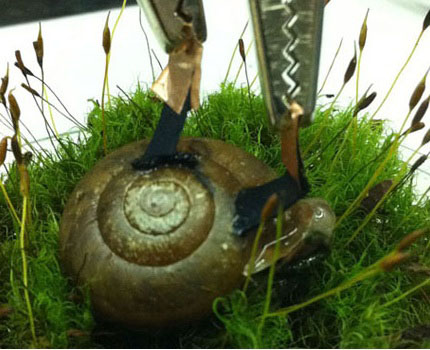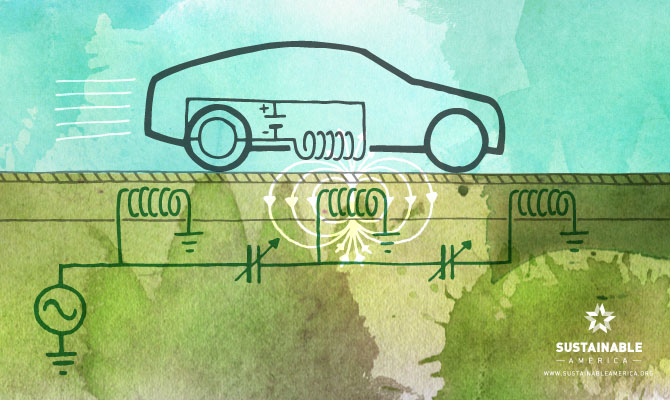Subscribe to our Newsletter
Get regular stories, tips and solutions from Sustainable America and opt-in to receive roundups of the latest food and fuel news.

Oct 31st, 2012 | By Aubrey Yee
Protean Electric claims to have a new system that will change how the engine in an electric vehicle works. The technology to power your car might someday be in your wheels...
Continue Reading
Oct 26th, 2012 | By Nicole Rogers
Real Time Farms makes it easy to eat local and make informed decisions about where your food comes from. It is a crowdsourced national food guide that helps users find certain foods grown or made in their area, and to add sources if they are lacking.
Continue Reading
Sep 26th, 2012 | By Aubrey Yee
Blue River Technology has created a weeding robot that could help to keep millions of pounds of herbicides out of the environment and out of our food.
Continue Reading

Aug 24th, 2012 | By Aubrey Yee
Imagine a $9 bicycle made from recycled cardboard! This is not a dream, but inventory Izhar Gafni's reality. After three years of persistent and tireless trial and error, the Israeli inventor has created a cardboard bicycle that withstands the elements, looks really cool and will help make biking financially accessible to millions more people worldwide. In the effort to reduce oil consumption, pioneers like Gafni are at the forefront of important and inspiring innovation.
Continue Reading
Jul 22nd, 2012 | By Aubrey Yee
Imagine if after eating your ice cream, you could eat the package that it came in. Might sound like fantasy, but thanks to Harvard Professor David Edwards, this idea has now become reality. It's a bold and innovative move towards eliminating plastic and paper in packaging using the principles of biomimicry, a practice that looks to models, systems and elements in nature to create solutions to human problems.
Continue Reading
Jul 17th, 2012 | By Aubrey Yee
The debate over GMOs (Genetically Modified Organisms) rages on with ballot initiatives this election year addressing the issue of proper labeling on food products containing GMOs, and a new batch of superweeds that are resistant to the herbicides used on GMO crops plaguing farmers across the country.
Continue Reading
Jul 8th, 2012 | By Aubrey Yee
Craig Venter is not your usual scientist. He's attractive and stylish, rides fast motorcycles and sails around the world. He's self diagnosed himself with ADHD, but this fact combined with his healthy ego may be the very reason he has gone so far in his field. He sets ambitious and seemingly impossible goals like mapping the human genome, which he did faster than anyone expected, and then he achieves them.
Continue Reading
Jun 7th, 2012 | By Aubrey Yee
For about the last 10,000 years we’ve been living in an epoch called the Holocene. This time period has been defined by the worldwide spread of the human race and a relatively stable climate. In 2000, renowned atmospheric chemist Paul Crutzen came to believe that he was no longer living in the Holocene. That in fact mankind’s affect on planetary systems had become so pervasive and so influential that a new era had begun. He named this new era the Anthropocene and over the next few years the term began to gain acceptance in first academic and then more popular circles.
http://vimeo.com/39048998
The Anthropocene, as Crutzen and others now see it, is “the recent age of man.” A time in which all manner of ecological processes from the macro to the micro are being changed and affected in significant ways by our presence on the planet. Acknowledging that humankind’s influence is central and ubiquitous is no small shift in thinking. It is in fact a massive paradigm shift in the scientific field. A field that previously saw humans as observers of natural processes rather than creators of them.
In 2009, Crutzen along with a group of academics, published a paper titled The Anthropocene: conceptual and historical perspectives in which they contend:
The human imprint on the global environment has now become so large and active that it rivals some of the great forces of Nature in its impact on the functioning of the Earth system…In this paper, we put forward the case for formally recognizing the Anthropocene as a new epoch in Earth history, arguing that the advent of the Industrial Revolution around 1800 provides a logical start date for the new epoch.
We live in a time where geoengineering, genetically modified organisms and artificial intelligence are part of our reality and increasingly we are finding new ways to both create and affect life. Crutzen and others believe that by acknowledging the advent of a new era we force ourselves to accept our new role in managing and stewarding the processes of the natural world. Rather than seeing humans as outside observers of nature, the Anthropocene asks us to envision humans as both creators and managers of a world that we are intimately interconnected with. There is a responsibility inherent in humankind’s ability to effect biological and chemical processes all the way down to the cellular level.
In 2009 a group of international academics joined forces to create the planetary boundaries manifesto which outlines nine planetary boundaries that must be maintained for life on planet earth to sustain. Published in the journal Nature, the group calls for intervention in planetary processes where we have crossed these boundaries so as to recreate and sustain the climactic environment we have adapted to during the Holocene era. In our new role as stewards of the future, the Anthropocene era challenges us to examine much more deeply our impact on the planet and all manners of life that depend upon Earth to survive.
Jun 1st, 2012 | By Aubrey Yee
When you think of ‘energy’, ‘snail’ is not usually the next word that comes to mind. But researchers at Clarkson University aim to change that. They have implanted a living snail with a biofuel cell that creates electricity using the snail’s natural glucose as fuel. Really, we’re not making this up!
The snail lives its life as usual with some electrodes implanted in its body and then connected to an external circuit. PETA may not love the technology, but the scientists involved in the study maintain that the snails live a happy and mostly uninterrupted life.
While the technology is admittedly in its infancy, the eventual idea is to create robotic life that can internally power itself. It’s no
surprise that the Department of Defense is very interested in the research. They have been looking for ways to increasingly remove live humans from battle and replace them with different types of robots.
 This research, published in the Journal of the American Chemical Society, is not the only paper dealing with electricity produced by living creatures. A similar study was just conducted by Daniel Scherson at Case Western Reserve University in Cleveland, Ohio. In his study, the creature of choice was a cockroach. Just imagine, your house could someday be powered by a hoard of wild cockroaches. Ew!
This research, published in the Journal of the American Chemical Society, is not the only paper dealing with electricity produced by living creatures. A similar study was just conducted by Daniel Scherson at Case Western Reserve University in Cleveland, Ohio. In his study, the creature of choice was a cockroach. Just imagine, your house could someday be powered by a hoard of wild cockroaches. Ew!
Photos: Clarkson University
May 29th, 2012 | By Aubrey Yee

You just got a shiny new electric vehicle, you’re hip and ready to go. Driving could be a dream, but where are you going to “fill up”?
What if you could charge your new car while driving it? Sounds fantastical, but actually the ability to charge while you drive with wireless technology may be just around the corner.
Researchers at Stanford have come up with a wireless charging technology that uses “magnetic resonance coupling” - in other words, copper coils in your car and in the ground transfer electricity between each other while you are driving. Charge while you’re driving and you never have to stop to refill your battery!
This potentially revolutionary new system is outlined in a paper recently published in the journal Applied Physics Letters.
While there are some kinks to be worked out, the idea behind the technology is quite innovative and tackles head on the “range anxiety” that many people feel when deciding whether or not to purchase an electric vehicle.
Imagine a carpool lane magnetized for electric cars only. It would require tearing up some of the freeway pavement, but the metal coils needed to make it run are very affordable. One more important innovation on the road to a new way of driving.
